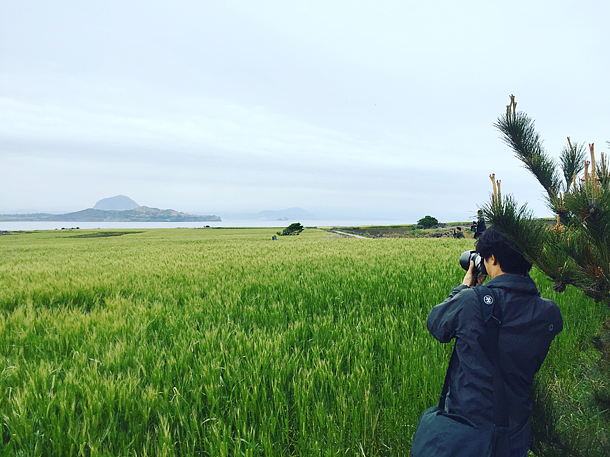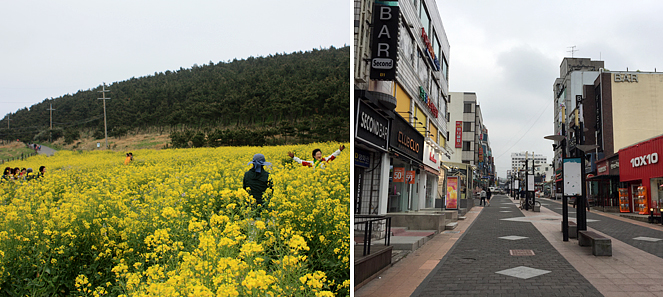With fewer Chinese travelers, Jeju shifts its focus: Tourism officials offer new sights to see for returning travelers

A visitor to Gapa Island takes a photo of barley fields with Mount Sanbang in the background. [LEE SUN-MIN]
These concerns grew more serious after the Chinese government announced on March 2 a ban on travel to Korea for Chinese tour groups from March 15. Since the announcement, Jeju Island has seen a 73.6 percent drop in the number of tourists from China, as of April 20, compared to the same period last year, according to Jeju Tourism Organization.
However, the sharp drop did not shock the overall tourism industry on the island. In fact, the total number of travelers to Jeju actually increased. The accumulated number of visitors to the island this year has increased by 2.3 percent to 4.3 million, as of April 20. The 9.5 percent increase of local travelers to Jeju compared to last year has driven the overall numbers up, while there was 27.7 percent drop in the total of foreign travelers.
Thanks to the steady number of travelers, those in the tourism sector are not discouraged, and have found a new momentum to work on how to appeal to other populations.
Deputy Minister Yu Dong-hun of the Ministry of Culture, Sports and Tourism said during his visit to Jeju last week that the government and the industry will work together to move away from the reliance on Chinese travelers, who made up around 47 percent of all travelers to Jeju last year.
Many new airlines will start routes in and out of Jeju, bringing in new travelers to the island. In March, Tigerair began operating a route between Taiwan and Jeju twice a week, and beginning in June, the flights will be available four times a week. Philippines Airlines has also decided to operate regular routes twice a week until Oct. 28. More flights from Hong Kong have been added since March. Journalists, bloggers and travel agency officials from Canada, Russia, the Philippines, Vietnam and Taiwan are being invited to experience Jeju and spread the word back home.
“Things may change due to the political situation, but now also is the time to reassess and make investments so that we can be ready when more come to visit the island,” said one clothing store owner who owns a shop on Baozen Street, a shopping district in Shinjeju, about 10 minutes from Jeju International Airport.
The local government has made a 30 billion won ($26.7 million) loan available to companies who have been directly hit by the absence of travel groups, such as chartered bus companies or local tour guides, so that they can seek ways to develop new markets for their service.

Left, a field covered with yellow rapeseed flower has become the must-visit spot during the spring. Right, Baozen Street in the Shinjeju area close to Jeju International Airport, which was popular among group Chinese travelers who want to shop for clothing, has been empty recently. [LEE SUN-MIN]
Different experience
The first step to make Jeju more appealing is identifying what’s best in each season.
A photo of a person posing in the middle of fields of yellow rapeseed flowers is a common indication that spring has arrived on the island. But those who want see something different should head out to the green fields of Gapa Island.
Gapa Island is located in the southwestern corner of Jeju. It is about 15 minutes away by ferry from Moseulpo harbor, close to Mount Sanbang. The island is particularly popular in the early spring as the island is covered in green barley fields. The view is quite different from the now common scene of a field filled with yellow flowers.
Fans of Mount Sanbang will enjoy the island as they have an excellent view of the mountain as a background to the scenery. The Jeju Tourism Organization has named the island one of the 10 spots to visit in April.
Many opt to walk around, but since the island is quite flat, bicycles are also an option. There is a rental shop by the ferry port on Gapa Island, and anyone can borrow a bike for 5,000 won. Those in elementary school or younger get a 1,000 won discount. There is no hourly charge and borrowers can bring back the bicycles anytime they want.
Standing in the middle of barley fields helps visitors find some peace and quiet. The island isn’t too busy, and people often spread out amongst the tall barley to take photos and appreciate the unhindered views of nature surrounding them.
If you still want a photo of a field of vibrant yellow rapeseed flowers, Mount Songak, about five minutes away by car from Moseulpo, is a great spot to visit after you leave Gapa Island.
More information on what sights are best to see in each month can be found on the website of the Jeju Tourism Organization. For more information, go to www.visitjeju.net or call 1330 or (064) 740-6000~1. The website is available in Korean, English, Chinese and Japanese.
BY LEE SUN-MIN [summerlee@joongang,co.kr]










with the Korea JoongAng Daily
To write comments, please log in to one of the accounts.
Standards Board Policy (0/250자)